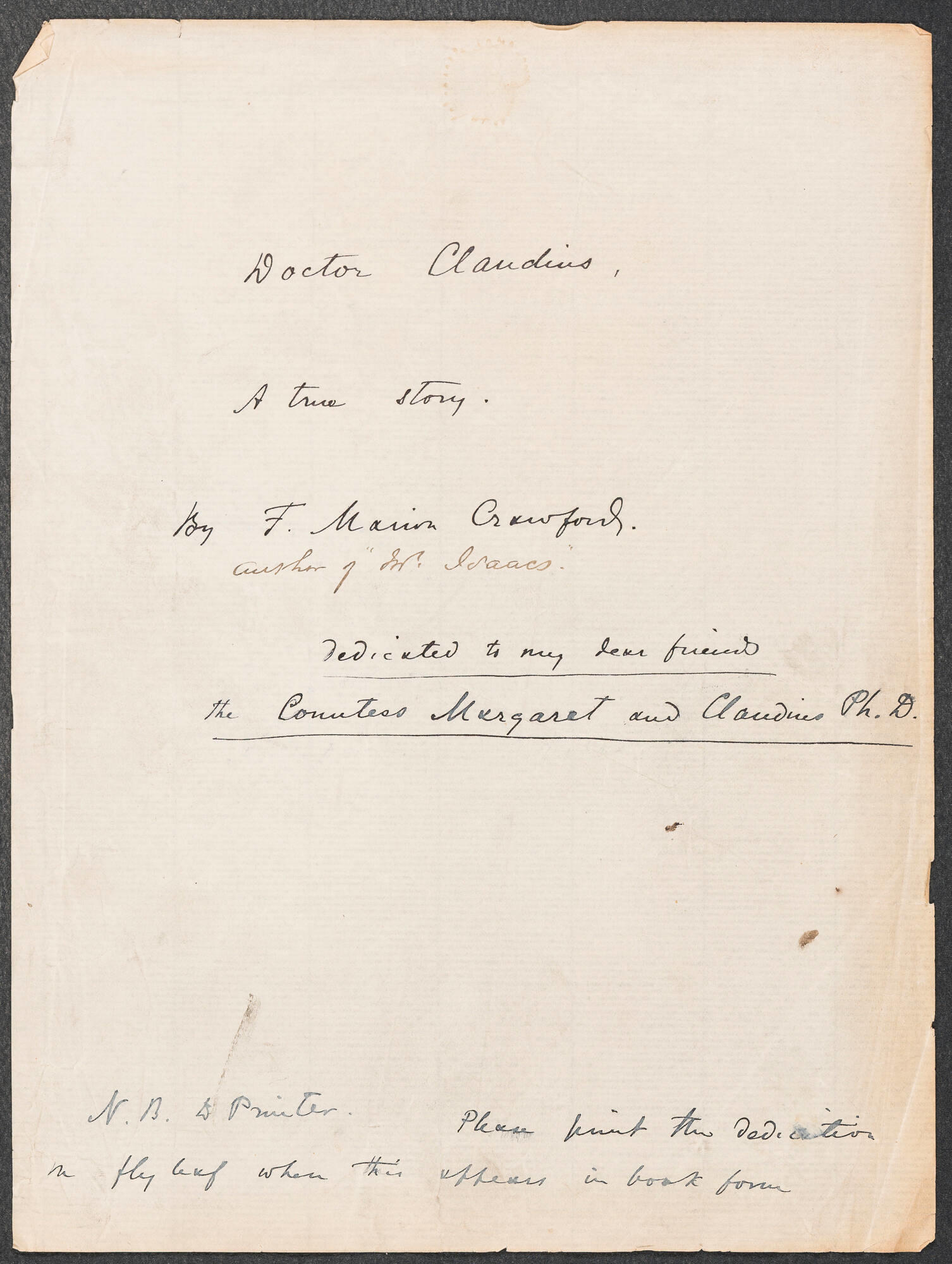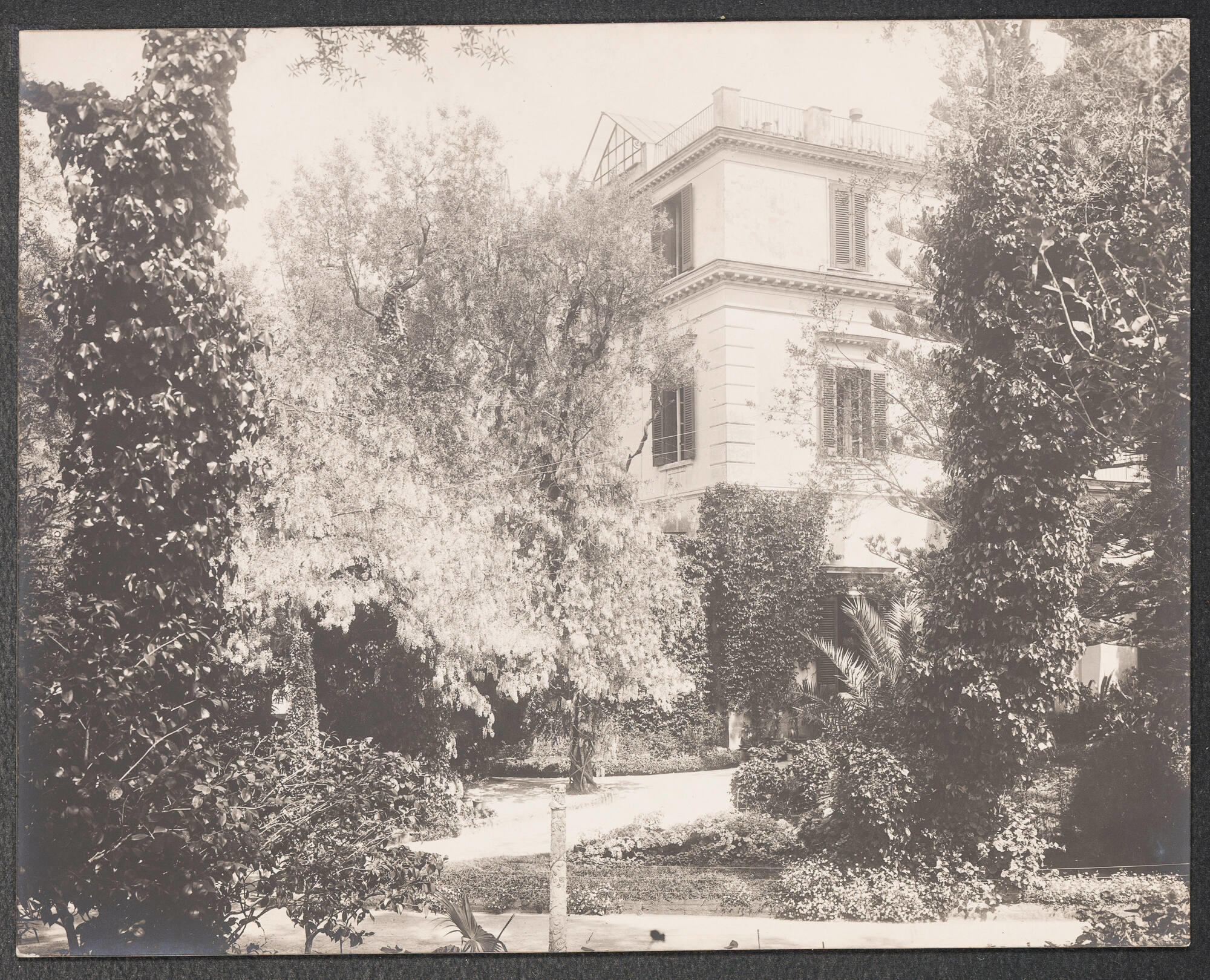In one of the glass topped cases in the Blue Room, Isabella Stewart Gardner included a photograph of two hands clasped with an Italian inscription. The hands belong to Isabella and the novelist F. Marion Crawford, who were forty-two and twenty-eight, respectively when the photo was taken in 1882. The inscription in Crawford's handwriting reads: "Two hands are united in love—one spirit united and a single heart." This photograph is just one part of the many letters, books, and manuscripts in the Crawford/Chapman Case.

Isabella Stewart Gardner Museum, Boston (ARC.006481). See it in the Crawford/Chapman Case.
A.B. Cross (active 19th century, Salem, Massachusetts), Clasped hands of F. Marion Crawford and Isabella Stewart Gardner, about 1882. Ink on albumen print, 21.4 x 13 cm (8 7/16 x 5 1/8 in.)
Rumors of an Affair
Crawford’s and Gardner’s close relationship inspired rumors of an affair to swirl around them, even prompting some to comment that John Singer Sargent’s iconic portrait of Isabella showed her cleavage "all the way to Crawford's Notch"—a pun referencing a pass in New Hampshire’s White Mountains. Throughout Gardner's life and even after her death, her connection to Crawford cast a long shadow. Some of Isabella's biographers and novelists have reveled in the scandal and, in sexist terms, portrayed her as a flirt who chased younger men. It is impossible to know whether or not the two had a physical affair, but one thing is clear: they greatly admired one another, and the surviving traces of that admiration have romantic undertones.

Isabella Stewart Gardner Museum, Boston (P30w1)
John Singer Sargent (American, 1856–1925), Isabella Stewart Gardner, 1888. Oil on canvas, 190 x 80 cm (74 13/16 x 31 1/2 in.)
Who Was F. Marion Crawford?
While Gardner remains famous, Crawford is less well-known than he once was. Friends and family described him as charming, intelligent, and very handsome. In her memoirs, his younger half-sister wrote that Frank, as his family often called him: "a darling of the gods, exceedingly handsome, tall, well-built, with blazing blue eyes and very regular features, an excellent brain and universal facility."1

Isabella Stewart Gardner Museum, Boston (ARC.006479)
Unidentified photographer, F. Marion Crawford, about 1882. Albumen on card, 23 x 17.9 cm (9 1/16 x 7 1/16 in.)
A prolific writer, he was famous in his day for both his historical and fantastical fiction. Born in 1854 in Italy to the American sculptor Thomas Crawford and Louisa Cutler Ward, he was raised primarily in Rome. He enrolled at various schools and universities in the United States and Europe before traveling to India in 1879 to study Sanskrit and work as a newspaper editor. While on the subcontinent, Crawford fell ill and ultimately headed home to Rome. In 1881, still searching for a clear career path, he came to the United States—first to spend time with an uncle in New York City and then ultimately came to Boston to live with his aunt, the famed suffragette Julia Ward Howe—who happened to be close friends with Isabella.

Isabella Stewart Gardner Museum, Boston (ARC.007827). Isabella kept this clipping in a book of Julia Ward Howe’s poetry in the Blue Room.
Unidentified newspaper, “Julia Ward Howe’s House,” 20th century. Newspaper clipping
Literary Success
During his stay in Boston, Crawford wrote his first novel—Mr. Isaacs: A Tale of Modern India (1882)—which proved to be an immediate success. The book launched his career, and he would go on to write dozens of novels. While his family was thrilled that the charming, if slightly wayward, twenty-eight-year-old had found his professional calling, surviving correspondence shows they were increasingly worried about his connection to a notable—and very much married—woman: Isabella Stewart Gardner.2

Isabella Stewart Gardner Museum, Boston (ARC.005242). Isabella displayed this manuscript in the Crawford/Chapman Case in the Blue Room.
F. Marion Crawford (American, 1854–1909), Mr. Isaacs: A Modern Tale of India, 1882. Title page: ink on paper
A Shared Love of Dante
Already traveling in the same social circles in the city, Gardner and Crawford bonded over a love of the Italian poet Dante and other intellectual pursuits. Smarting from a recently failed attempt to marry a young woman named Mary Perkins, Crawford's most recent biographer speculates that the author was particularly in need of the attention of someone like Gardner, who took his work seriously and with whom he could ask for advice and discuss a wide range of topics about life, art, and history. The pair were not subtle in demonstrating their affection for one another, and Crawford wrote to his mother in March of 1882.
If you hear rumors of my attachment to a certain married lady, do not be distressed. She has been a good friend to me in trouble and is one of the purest and best women living—in spite of the slandering tongues of petty Boston.
At Isabella's invitation, he spent time at the Gardner family vacation home in Prides Crossing on Massachusetts' north shore in the summer of 1882. During this stay, he wrote much of his second novel, Doctor Claudius—a handwritten copy remains in the Museum’s collection. Central to the book's plot is a romantic relationship between a young professor and an older American woman who is the widow of a count. The fact that the plot of Crawford's newly drafted book featured a romance between an older woman and a younger man probably did not help allay any fears.
More private evidence also shows Crawford's fondness for Isabella. He wrote her a “Sonnett” [sic] still in the collection.
My lady late within my chamber tarries
In sweet dark versture, all her fair hair flowing
In ripples o'er her shoulders, and she carries
Her beauty with such royal air, as sowing
Her with with jewels from love’s Treasure quarries.
Rumors
Eventually, despite Crawford's warnings to his mother to ignore "the slandering tongues of petty Boston," there seems to have been too much suggestive rumor around the connection between the married society leader and the young author. Recollections and writings within the Crawford and Howe families are specifically vague—but suggestive—about how the perceived attachment between Isabella and Frank precipitated the young author's abrupt departure from Boston in the spring of 1883. Soon, Crawford was back in Italy, where he lived for the rest of his life, becoming a prolific writer and a married father of four children. His home, Villa Crawford, in Sorrento, just outside of Naples, still exists.
One can never know what happened in Victorian bedrooms—romantic friendships that were intensely emotional but respected the strict moral boundaries governing physical intimacy were common at the time. Often discussed in the context of same-sex pairings, they could also occur between men and women. Regardless of what happened between them physically, it is clear that Crawford and Gardner had a deep affection for one another. A decade after he left Boston, Crawford and Isabella reconnected, and in 1893, he gave her an extraordinary gift. He sent their copies of Dante's Divine Comedy—presumably the ones they had read together—to Tiffany & Co. to be interleaved and exquisitely bound together in green leather and silver.
Etched on the combined volume's silver clasp is: "The two are one." On the first page, an excerpt from Paradiso (33.86–87) appears: “Legato con amore in un volume / ciò che per l’universo si squaderna” (Bound with love in one volume / all that is scattered throughout the universe).
You May Also Like

Read More on the Blog
Isabella and the Dante Society

Read More on the Blog
Jack Gardner: A Collector in His Own Right

Read More on the Blog
The Story Behind John Singer Sargent’s Portrait of Isabella
1 Margaret Terry Chanler, Roman Spring: Memoirs (Boston: Little, Brown and Company, 1934), 37.
2 Houghton Library, Harvard University






